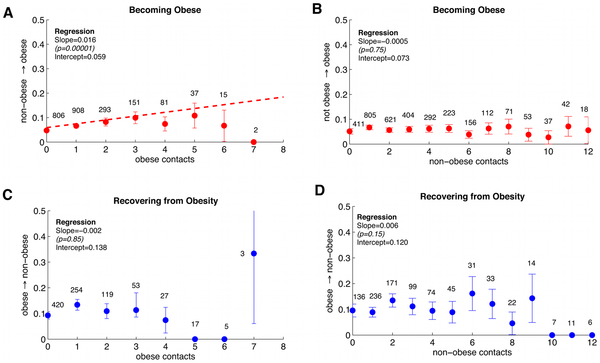If so, America's obesity epidemic won't plateau until at least 42 percent of adults are obese, according to their estimate derived by applying mathematical modeling to 40 years of Framingham Heart Study data.
Their work is contrary to recent assertions by some experts that the obesity rate has peaked at around 34 percent. 34 percent more American adults are overweight but not obese, according to the federal government's Centers for Disease Control and Prevention estimates. The Harvard group say their modeling shows that the proliferation of obesity among American adults in recent decades owes in large part to its accelerating spread via social networks.
"Specifically, the rate of weight gain due to social transmission has grown quite rapidly," says lead author Alison L. Hill, a graduate student in Harvard's Program for Evolutionary Dynamics, Biophysics Program, and at the Harvard-MIT Division of Health Sciences and Technology.
Hill says their projections are a best-case scenario, meaning that America's obesity rate could rise above 42 percent of adults but their math is somewhat simple - mapping the last 40 years to the next. The future rate of increase may be much more gradual than over the past 40 years because only 14 percent of Framingham Heart Study participants were obese in 1971.
But people are generally healthier than 40 years ago also so why hasn't exercise spread if the social hypothesis is valid? It's easier to gain weight than lose it, though the social aspects of weight gain hold true for fit people as well. They say a non-obese American adult has a 2 percent chance of becoming obese in any given year and that this number rises by 0.4 percentage points with each obese social contact, meaning that five obese contacts doubles the risk of becoming obese.
So eat all the pizzas you want but don't be friends with fat people and you'll be fine.
Evidence for disease-like spread of obesity, according to a Harvard model. Obesity behaves like a disease agent, infecting those in a susceptible ‘not obese’ state. The probability of transitioning from ‘not obese’ to ‘obese’ increases in the number of ‘obese’ contacts (A), and doesn't depend on the number of ‘not obese’ contacts (B). Conversely, the probability of recovering to the ‘not obese’ state does not depend on the number of ‘not obese’ contacts (D) or the ‘obese’ contacts (C)). Labels above points on plot are the number of observations averaged into that data point, and error bars are the standard error of the proportion. Credit: see citation
- the rate at which obesity has spread through social networks, via transfer from person to person;
- the rate of non-social transmission of obesity, such as through easier access to unhealthy foods or increasingly sedentary lifestyles;
- the rate of "recovery" from obesity, defined as weight loss sufficient to push body mass index (BMI) back below 30.
"We find that while non-social transmission of obesity remains the most important component in its spread, social transmission of obesity has grown much faster in the last four decades," says David G. Rand, a research scientist in the Program for Evolutionary Dynamics and a fellow in Harvard's Department of Psychology and Berkman Center for Internet&Society.
By comparison, an obese adult has a 4 percent chance of losing enough weight to fall back to merely "overweight" in any given year. This figure has remained essentially constant since 1971."These results suggest that social norms are changing the propensity for becoming obese by non-social mechanisms, and also magnifying the effect that obese individuals have on their non-obese contacts," the scientists write in the PLoS Computational Biology article.
Citation: Hill AL, Rand DG, Nowak MA, Christakis NA (2010) Infectious Disease Modeling of Social Contagion in Networks. PLoS Comput Biol 6(11): e1000968. doi:10.1371/journal.pcbi.1000968





Comments